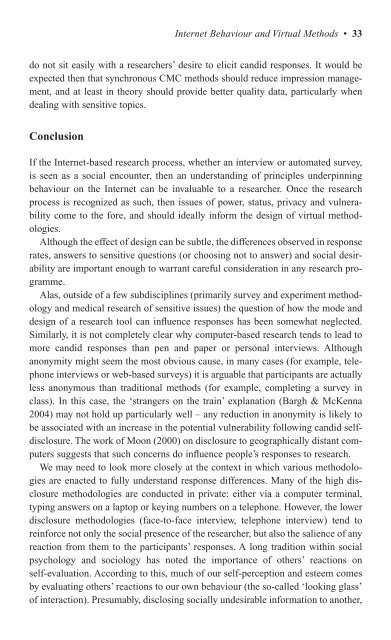Virtual Methods
Virtual Methods
Virtual Methods
Create successful ePaper yourself
Turn your PDF publications into a flip-book with our unique Google optimized e-Paper software.
do not sit easily with a researchers’ desire to elicit candid responses. It would be<br />
expected then that synchronous CMC methods should reduce impression management,<br />
and at least in theory should provide better quality data, particularly when<br />
dealing with sensitive topics.<br />
Conclusion<br />
Internet Behaviour and <strong>Virtual</strong> <strong>Methods</strong> • 33<br />
If the Internet-based research process, whether an interview or automated survey,<br />
is seen as a social encounter, then an understanding of principles underpinning<br />
behaviour on the Internet can be invaluable to a researcher. Once the research<br />
process is recognized as such, then issues of power, status, privacy and vulnerability<br />
come to the fore, and should ideally inform the design of virtual methodologies.<br />
Although the effect of design can be subtle, the differences observed in response<br />
rates, answers to sensitive questions (or choosing not to answer) and social desirability<br />
are important enough to warrant careful consideration in any research programme.<br />
Alas, outside of a few subdisciplines (primarily survey and experiment methodology<br />
and medical research of sensitive issues) the question of how the mode and<br />
design of a research tool can influence responses has been somewhat neglected.<br />
Similarly, it is not completely clear why computer-based research tends to lead to<br />
more candid responses than pen and paper or personal interviews. Although<br />
anonymity might seem the most obvious cause, in many cases (for example, telephone<br />
interviews or web-based surveys) it is arguable that participants are actually<br />
less anonymous than traditional methods (for example, completing a survey in<br />
class). In this case, the ‘strangers on the train’ explanation (Bargh & McKenna<br />
2004) may not hold up particularly well – any reduction in anonymity is likely to<br />
be associated with an increase in the potential vulnerability following candid selfdisclosure.<br />
The work of Moon (2000) on disclosure to geographically distant computers<br />
suggests that such concerns do influence people’s responses to research.<br />
We may need to look more closely at the context in which various methodologies<br />
are enacted to fully understand response differences. Many of the high disclosure<br />
methodologies are conducted in private: either via a computer terminal,<br />
typing answers on a laptop or keying numbers on a telephone. However, the lower<br />
disclosure methodologies (face-to-face interview, telephone interview) tend to<br />
reinforce not only the social presence of the researcher, but also the salience of any<br />
reaction from them to the participants’ responses. A long tradition within social<br />
psychology and sociology has noted the importance of others’ reactions on<br />
self-evaluation. According to this, much of our self-perception and esteem comes<br />
by evaluating others’ reactions to our own behaviour (the so-called ‘looking glass’<br />
of interaction). Presumably, disclosing socially undesirable information to another,



